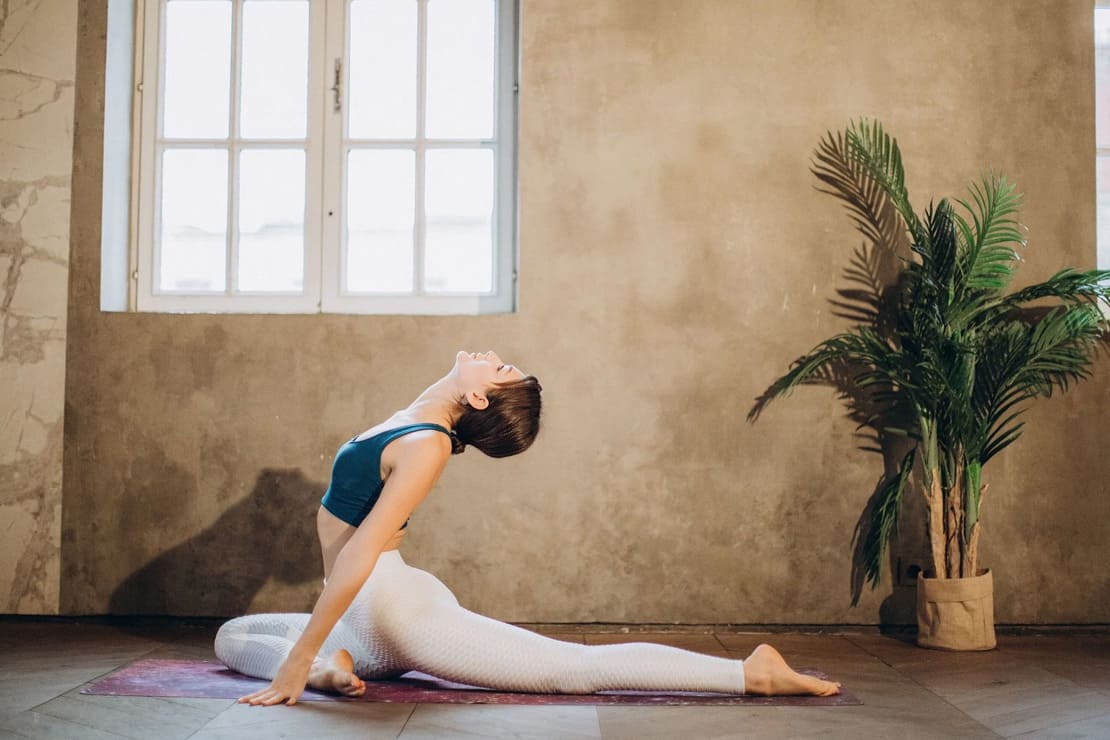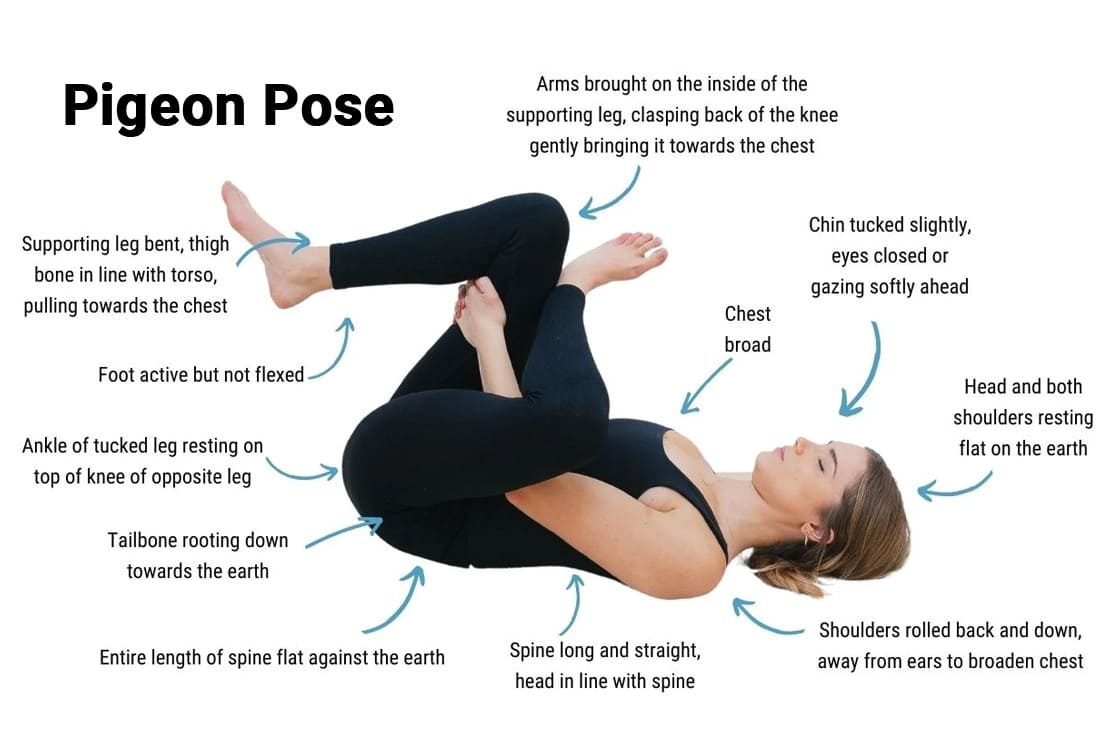The pigeon pose is also known as “Eka Pada Rajakapotasana”. Where ‘eka’ means one, ‘pada’ means foot, ‘raja’ means king, ‘kapota’ means pigeon, and ‘ asana’ means pose. A few people also called it the One-Legged King Pigeon Pose, but Sanskrit names are usually used for naming the postures. It is a very helpful pose for stretching the hip flexors and gluteal muscles. To begin the pose first you need to start with a plank pose with straight arms and palms toward the ground surface. Then fold one leg and bring it forward. Then lower your body down. Your forehead should be resting on your wrist as you lower your upper body to the ground. The posture is frequently practiced to tighten the pelvis as well as enhance lower body suppleness.

Benefits of Pigeon Pose
Some benefits of pigeon pose are as follows-
- The pigeon pose improves hip flexibility and focuses on hip flexors, our hips become stiff because of the long sitting duration.
- Improves body posture- sitting in wrong or discomfort position can lead to thigh-hip flexors. By practicing pigeon posture regularly, you can relax your spine and improves your posture by stretching your hip flexors.
- It helps in relaxation and relief of stress- tightness in the glutes and hips can be reduced by practicing the pigeon pose, this poses stretch these parts which in return provides calmness and soothing.
- It also helps in improving digestion- pigeon pose activates the digestion system, and improves bowel movement.
- It improves overall blood circulation which can also increase energy levels.
As with any yoga pose, it’s crucial to pay attention to your body and avoid overextending yourself. Pigeon position should be modified to fit their preferences if you experience discomfort or pain while performing it.
Step-by-Step Instructions for pigeon pose
Following are detailed directions for doing the Pigeon Pose:
- Begin on your hands and knees in a tabletop posture, with your forearms under your shoulders and your knees under your hips.
- Put your right leg behind your right forearm by bringing it forward. Your ankle should be close to your left shoulder but also your leg ought to be positioned at an angle.
- Stretch your left leg behind you while keeping your left elbow on the floor. Your left foot should be securely grounded on the ground, and your left leg should be straight.
- Start bringing your upper body to the ground while stretching your arms out in front of you if you feel comfortable doing so. You can put your forehead on them while resting your elbow on the ground.
- Hold the posture for 5-10 long breaths, then gently raise your body back up to the tabletop position.
- By stretching your right leg behind you and pulling your left knee forward, replicate the position on the opposite side.
Beginners tips
Here are some pointers for newcomers to the pigeon pose:
- Beginning with a warm-up Warming up the muscles before trying Pigeon Pose is essential because the posture can be a profound stretch for the hips. Before entering Pigeon Pose, try some easy hip-opening poses like Butterfly Pose or Figure Four Posture.
- Use props: You can support your body with pillows or blocks if Pigeon Posture is too strenuous for you. To support your hip, place a cushion or folded cloth under it. You can also use a block to raise your wrists or shoulders.
- It’s essential to not push your body into the stretch because Pigeon Pose is a profound stretch. Pushing yourself past your boundaries is never a good idea. Instead, allow your body to relax into the stretch progressively. If you experience any pain or discomfort, adjust the posture or ease off.
- To prevent stress on your legs or lower back while performing Pigeon Pose, it’s critical to maintain level hips. Use a cushion or folded towel to support your right hip if it starts to rise off the floor.
- Regular practice is necessary to perfect Pigeon Pose, just like any other yoga posture. Try to perform the posture regularly, and you might notice that it becomes more relaxed and your hips become more supple over time.
- Breathe steadily and profoundly as you assume the pigeon pose. Utilize your breathing to help you ease into the stretch by concentrating on it.
Always pay attention to your body’s signals and avoid overexerting yourself. Pigeon Pose should be modified to fit your requirements if you feel pain or distress while performing it. You can progressively improve your flexibility and feel more at ease in the position with consistent exercise and patience.

Cautions while performing pigeon pose
Although Pigeon Pose can offer many benefits, there are some cautions to keep in mind when practicing this pose:
- Knee pain: If you have any knee injuries or pain, be cautious when practicing Pigeon Pose. You may need to modify the pose by placing a cushion or folded blanket under your right thigh to support your knee.
- Lower back pain: If you have lower back pain, be cautious when practicing Pigeon Pose. You may need to use props like a cushion or folded blanket to support your hips or try a modified version of the pose with your upper body more upright.
- Hip injuries: If you have any hip injuries, be cautious when practicing Pigeon Pose. You may need to avoid the pose altogether or modify it by using props to support your body.
- Avoid overstretching: Pigeon Pose is a deep stretch for the hips, but it’s important not to overstretch or force your body into the pose. Let your body relax into the stretch gradually, and avoid pushing yourself beyond your limits.
- Keep your hips level: It’s essential to keep your hips level in Pigeon Pose to avoid strain on your knees or lower back. If your right hip lifts off the ground, use a cushion or folded blanket to support it.
- Listen to your body: Always listen to your body and practice the pose with awareness. If you experience pain or discomfort during Pigeon Pose, you should back off or modify the pose to suit your needs.
If you have any concerns or injuries, it’s always a good idea to consult with a qualified yoga teacher or healthcare professional before practicing Pigeon Pose or any other yoga poses. Join our Yoga School in Rishikesh to Learn Yoga in Rishikesh, our 200 hours of Yoga Teacher Training in Rishikesh and 100 hours of Yoga Teacher Training in Rishikesh are best for Yoga aspirants
